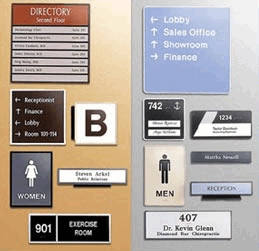Checking Out the Trick Attributes of ADA Signs for Improved Access
In the realm of access, ADA indicators serve as silent yet powerful allies, guaranteeing that rooms are accessible and inclusive for people with specials needs. By integrating Braille and tactile elements, these signs break obstacles for the aesthetically impaired, while high-contrast color plans and clear font styles provide to diverse aesthetic demands.
Significance of ADA Compliance
Guaranteeing conformity with the Americans with Disabilities Act (ADA) is critical for cultivating inclusivity and equivalent access in public spaces and work environments. The ADA, enacted in 1990, mandates that all public facilities, companies, and transport services fit people with handicaps, ensuring they delight in the same legal rights and opportunities as others. Compliance with ADA criteria not only meets legal obligations but additionally boosts an organization's track record by showing its dedication to variety and inclusivity.
One of the key aspects of ADA compliance is the application of available signage. ADA indicators are designed to make certain that people with disabilities can conveniently browse with structures and areas.
Additionally, sticking to ADA laws can reduce the danger of possible penalties and lawful consequences. Organizations that fail to conform with ADA guidelines may encounter legal actions or fines, which can be both destructive and financially challenging to their public photo. Therefore, ADA compliance is essential to promoting an equitable setting for every person.
Braille and Tactile Components
The incorporation of Braille and tactile aspects into ADA signs symbolizes the concepts of availability and inclusivity. It is commonly positioned beneath the matching message on signage to ensure that people can access the details without aesthetic aid.
Tactile components prolong past Braille and consist of raised icons and characters. These elements are made to be noticeable by touch, permitting people to identify area numbers, washrooms, leaves, and other crucial areas. The ADA establishes certain standards relating to the dimension, spacing, and placement of these responsive elements to maximize readability and guarantee uniformity throughout different settings.

High-Contrast Shade Schemes
High-contrast color schemes play a crucial duty in boosting the presence and readability of ADA signage for people with aesthetic disabilities. These plans are essential as they make best use of the difference in light reflectance in between text and background, ensuring that indications are easily discernible, also from a distance. The Americans with Disabilities Act (ADA) mandates the usage of certain color contrasts to suit those with minimal vision, making it an essential aspect of conformity.
The efficacy of high-contrast shades depends on their capability to stick out in various illumination conditions, including dimly lit settings and locations with glow. Typically, dark message on a light history or light text on a dark background is utilized to attain optimum contrast. As an example, black message on a yellow or white history provides a raw aesthetic difference that helps in quick recognition and comprehension.

Legible Fonts and Text Size
When considering the style of ADA signage, the choice of readable font styles and suitable message dimension can not be overstated. The Americans with Disabilities Act (ADA) mandates that view website font styles should be not italic and sans-serif, oblique, manuscript, extremely ornamental, or of unusual kind.
According to ADA standards, the minimum message elevation need to be 5/8 inch, and it must enhance proportionally with viewing range. Uniformity in text size adds to a natural visual experience, assisting people in browsing environments successfully.
Furthermore, spacing between lines and letters is important to readability. Appropriate spacing stops personalities from appearing crowded, boosting readability. By adhering to these requirements, designers can dramatically boost ease of access, making certain that signs offers its desired function for all people, no matter of their aesthetic abilities.
Reliable Positioning Approaches
Strategic positioning of ADA signage is essential for making best use of accessibility and ensuring compliance with legal standards. Appropriately positioned signs direct people with specials needs effectively, facilitating navigating a knockout post in public spaces. Secret factors to consider consist of visibility, proximity, and elevation. ADA guidelines stipulate that indications ought to be installed at a height between 48 to 60 inches from the ground to ensure they are within the line of view for both standing and seated people. This common height variety is crucial for inclusivity, allowing mobility device individuals and individuals of differing elevations to gain access to details effortlessly.
In addition, signs need to be put beside the lock side of doors to enable simple recognition prior to entrance. This placement assists individuals locate spaces and areas without blockage. In instances where there is no door, indicators should be located on the nearby adjacent wall surface. Consistency in sign placement throughout a center boosts predictability, decreasing confusion and improving overall individual experience.

Final Thought
ADA signs play a vital informative post function in promoting availability by integrating features that address the demands of people with disabilities. Incorporating Braille and responsive aspects makes sure crucial info comes to the visually impaired, while high-contrast color design and understandable sans-serif typefaces enhance visibility throughout various illumination problems. Reliable placement strategies, such as ideal installing heights and calculated locations, even more assist in navigating. These aspects collectively cultivate an inclusive atmosphere, highlighting the significance of ADA conformity in making sure equal access for all.
In the world of ease of access, ADA signs serve as silent yet powerful allies, making certain that spaces are inclusive and accessible for individuals with specials needs. The ADA, passed in 1990, mandates that all public facilities, companies, and transport services suit people with disabilities, guaranteeing they delight in the exact same civil liberties and possibilities as others. ADA Signs. ADA indicators are developed to ensure that people with impairments can quickly browse through areas and structures. ADA guidelines state that signs should be placed at a height between 48 to 60 inches from the ground to guarantee they are within the line of sight for both standing and seated individuals.ADA signs play an important duty in promoting access by integrating features that attend to the demands of people with impairments